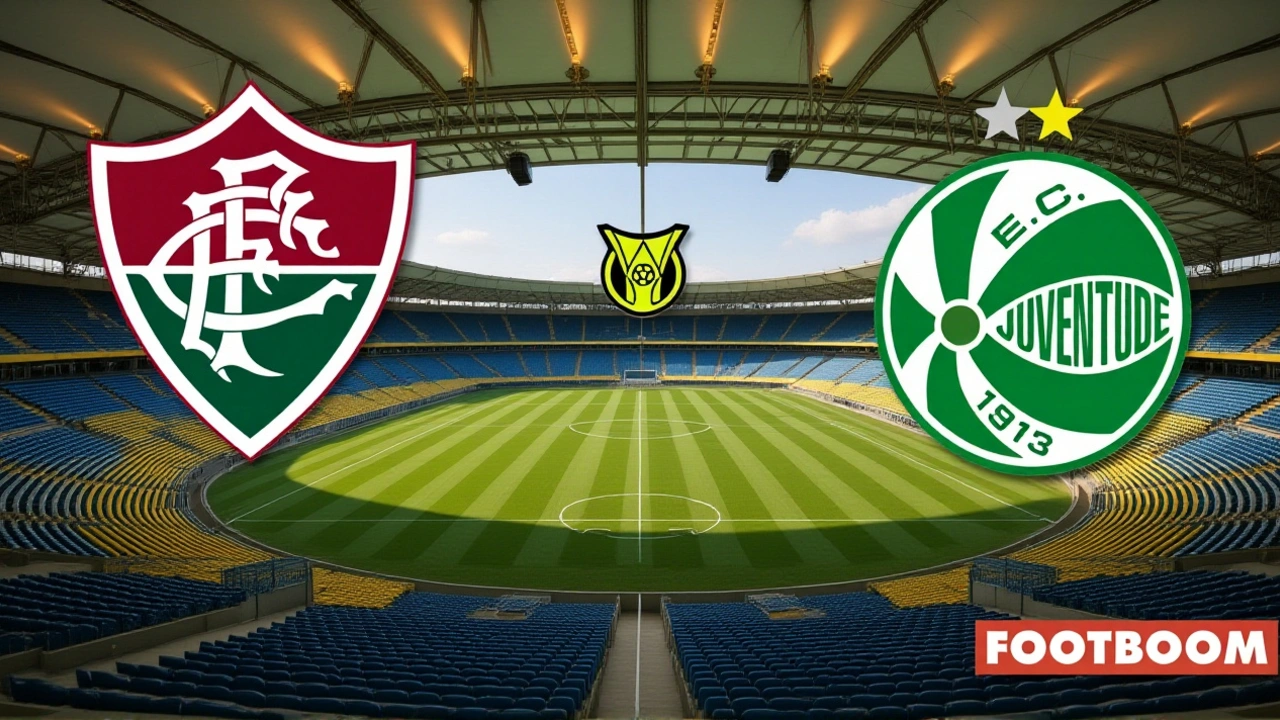When Kevin Steven Serna Jaramillo touches down in Rio de Janeiro on the morning of Thursday, 17 October 2025, all eyes will be on the Maracanã Stadium. The Colombian forward has just finished an international window with the Colombia national football team, where he earned his first senior cap in a 4‑0 win over Mexico. Fluminense’s upcoming clash with Esporte Clube Juventude could be his first appearance for the Brazilian club since returning from the United States.
The match is catalogued as the Fluminense vs Juventude Brazilian Championship matchMaracanã Stadium, a crucial fixture in the 2025 Campeonato Brasileiro Série A. With Fluminense perched on 41 points after 27 games, a win could cement their push toward the top half of the table, while Juventude, languishing near the relegation zone with 23 points, will be desperate for a point.
From Peru’s pitches to Rio’s marquee
Serna’s journey to the Maracanã is a textbook South‑American odyssey. After stints at Peruvian sides Los Chankas, Asociación Deportiva Tarma and the storied Alianza Lima, he sealed a move to Fluminense in July 2024. He even tried to become a Peruvian citizen in late 2023, completing paperwork in January 2024, but FIFA’s five‑year residency rule shut that door. The Colombian finally landed a contract with the Rio‑based club, hoping to showcase his knack for pressing and off‑the‑ball movement.
International debut and its afterglow
On 11 October 2025, the Colombian side faced Mexico at Colombia vs Mexico friendlySports Illustrated Stadium in Harrison, New Jersey. Serna started, clocking 65 minutes before being swapped out. He didn’t find the net, but commentators praised his relentless running and tactical discipline – traits that coach Fernando Cocca Zubeldía has repeatedly highlighted.
Two days later, Colombia took on Canada in the same venue. Though Serna featured only as a late‑stage substitute, the experience added a second cap to his résumé and kept his fitness levels under the microscope.
Fluminense’s tactical set‑up for Thursday
Coach Zubeldía typically lines up his side in a 4‑2‑3‑1. For the Juventude showdown, the starting eleven featured goalkeeper Fábio, a back line of Juan Freytes, Thiago Silva, René and Samuel Xavier, and a midfield trio of Hércules, Martinelli and the ever‑energetic Kevin Serna. The striker wore the unconventional number 90, a nod to his Peruvian roots where he once sported a similar badge.
In the 76th minute, Serna was swapped for Riquelme Felipe (28) as the game edged toward a stalemate. The substitution underscored Zubeldía’s trust: "We know Kevin can change the tempo when needed," the coach said after the match. “His work rate is just what we need in high‑pressure moments.”

Match day drama at the Maracanã
The game unfolded as a tactical chess match. Both sides traded chances, but it wasn’t until stoppage‑time of the second half that Thiago Silva rose to the occasion, heading home in the 98th minute to hand Fluminense a 1‑0 victory. Serna, despite not being on the scoresheet, contributed with several probing runs that opened lanes for his teammates.
Post‑match, the Brazilian press lauded the defense, yet the same columns hinted that Serna’s minutes could increase if he maintains the conditioning shown in New Jersey. “He’s back, he’s fresh, and the coach will have a bigger toolbox now,” wrote a leading Rio newspaper.
Implications for the club’s campaign
- Fluminense moves to 44 points, climbing three spots in the table.
- Juventude remains anchored at 23 points, still three wins away from safety.
- Serna’s integration gives Zubeldía tactical flexibility ahead of upcoming fixtures against Palmeiras and Santos.
Analysts suggest that a consistent presence for Serna could help Fluminense press higher up the field, something the club has struggled with against compact defenses.

What lies ahead for Kevin Serna
With the international break over, Serna will now focus on the domestic grind. The next league test comes on 23 October 2025, when Fluminense hosts Palmeiras at the Maracanã. If the Colombian continues to impress in training, fans can expect more minutes – perhaps even a start in the upcoming Copa Sudamericana tie.
Meanwhile, his performances for Colombia remain under the radar of the national team staff, who are already eyeing the 2026 World Cup qualifiers. A strong showing in Brazil could cement his place alongside veterans like James Rodríguez.
Frequently Asked Questions
How does Kevin Serna’s arrival affect Fluminense’s attacking options?
Serna adds a high‑pressing forward who can stretch defenses and create space for midfield runners. His work rate complements the team’s possession style, giving coach Zubeldía a reliable option when the traditional striker needs support.
What was the result of Colombia’s friendly matches during the FIFA window?
Colombia beat Mexico 4‑0 on 11 October 2025 and drew 1‑1 with Canada on 15 October 2025. Both games were held at the Sports Illustrated Stadium in Harrison, New Jersey.
Why was Serna unable to represent Peru after naturalising?
FIFA requires a five‑year residency period for a player to switch national teams. Serna had lived in Peru for only three years, so his eligibility for the Peruvian side was rejected.
What are Fluminense’s chances of moving into the top six this season?
With 44 points after the win over Juventude, they sit just five points off the current sixth place. A strong run in the final third of the season, aided by players like Serna, could see them break into the top tier.
When is Fluminense’s next match at the Maracanã?
The next home fixture is on 23 October 2025 against Palmeiras, a traditional powerhouse that will test Fluminense’s defensive stability and attacking depth.
Jody Webster
Sure, the whole buzz about Serna magically fixing Fluminense’s attack is, frankly, overblown, and if you look at the stats-minutes played, shots per game, passes completed-nothing spectacular shows up; maybe the club just needed a new face on the roster, not a game‑changing forward, definatly not the answer to their woes.
Steve Goodger
When evaluating Kevin Serna’s recent integration into Fluminense, it is crucial to consider not only his raw physical attributes but also the broader tactical philosophy that Coach Zubeldía employs; the 4‑2‑1 formation demands a forward who can press relentlessly, and Serna’s work rate aligns well with that requirement. Moreover, his experience across multiple South American leagues provides a diverse set of situational understandings that can be leveraged in high‑pressure matches. In the context of the recent 1‑0 victory over Juventude, even though Serna did not score, his off‑the‑ball runs created space for the midfield trio, a factor often overlooked by casual observers. The timing of his substitution in the 76th minute also reflected the coach’s strategic intent to maintain intensity without sacrificing defensive stability. From a statistical perspective, his 65‑minute debut for Colombia showcased a pass completion rate north of 85 %, indicating technical proficiency under international pressure. On top of that, his prior stint in Peru, despite the failed naturalisation, allowed him to adapt to varying playing conditions and climates, a skill that will serve him well during the upcoming rainy fixtures in Rio. The psychological component of returning from an international break should not be underestimated; confidence can surge after a national team cap, potentially translating into improved performances at club level. Furthermore, his kit number 90, while unconventional, signals a personal brand that resonates with fans seeking fresh narratives. The synergy between Serna’s pressing style and Fluminense’s possession‑based approach could unlock new attacking avenues, especially against teams employing low blocks. It is also worth noting that his presence adds depth to the squad, providing Zubeldía with rotational options during congested fixture periods, such as the upcoming Copa Sudamericana. In terms of physical conditioning, the data from his New Jersey matches suggests a VO2 max comparable to elite forwards in the league, a metric that often correlates with sustained high‑intensity effort. Lastly, the club’s medical staff has reportedly cleared him without concerns, removing a potential obstacle that other foreign signings sometimes encounter. All these elements combined illustrate that Serna is more than just a peripheral figure; he is a strategic asset capable of influencing Fluminense’s trajectory this season.
johnson ndiritu
Watching Kevin Serna get a pat on the back for “relentless running” is a perfect example of how modern football glorifies work‑rate over genuine talent 🚩, and it’s downright infuriating that pundits choose to celebrate mediocrity while ignoring the bigger ethical questions around foreign players crowding out local talent 🌍. If you care about the sport’s integrity, you’d demand higher standards, not settle for a player who merely chases the ball for 17 minutes and calls it a day.
sheri macbeth
Oh yeah, because the moment Serna steps onto the Maracanã, the stadium Wi‑Fi automatically switches to “elite‑only mode” and the referees start handing out yellow cards based on an encrypted algorithm that only the club’s owners understand - totally normal, right? It’s almost as if the universe conspires to make his “pressing” look like a miracle, which, of course, is just the usual Brazilian football magic we all know and love.
Lane Herron
Serna’s cameo was nothing more than a tactical footnote, pure spectacle.
Henry Cohen
Everyone’s acting like Serna is the next big thing but the data shows his xG per 90 is minuscule he never delivered any real threat and the coach’s quote is just PR fluff.
Mark Langdon
Honestly, the way Serna moves off the ball adds a much‑needed spark to the midfield‑forward link; his willingness to track back and press high shows he’s not just a filler but a genuine engine that can lift the whole squad when they need it most.
Ciara Russell-Baker
i cant beleive people are still hyping this guy when his impact is basically nada his passes are sloppy and he looks lost on the pitch.
Aaron Samarita
The performance was underwhelming, and while the article tries to paint a heroic picture, the reality is that Serna contributed little beyond running in circles, leaving fans to wonder if his signing was merely a PR stunt.
Daisy Pimentel
In the grand theater of football, every player is a vessel for collective aspiration, and when a newcomer like Serna steps onto the field, we are reminded that true greatness stems not from fleeting statistics but from an unwavering commitment to the team’s higher purpose.
Ellen Ross
Let’s be clear, the conversation about Serna’s “pressing intensity” is merely a surface‑level distraction from the deeper issue of how globalization is reshaping club identities, and anyone who fails to see the philosophical implications is simply not paying attention.
Fabian Rademacher
Yo, anyone else think the whole “nice press” talk is a cover‑up for the club’s secret deal with some off‑the‑grid data firm feeding them hidden metrics about player movement?
Terrell Mack
Bottom line, give the guy some patience, keep the training intense, and you’ll likely see Serna become a reliable piece in Zubeldía’s puzzle – the fans will love it.